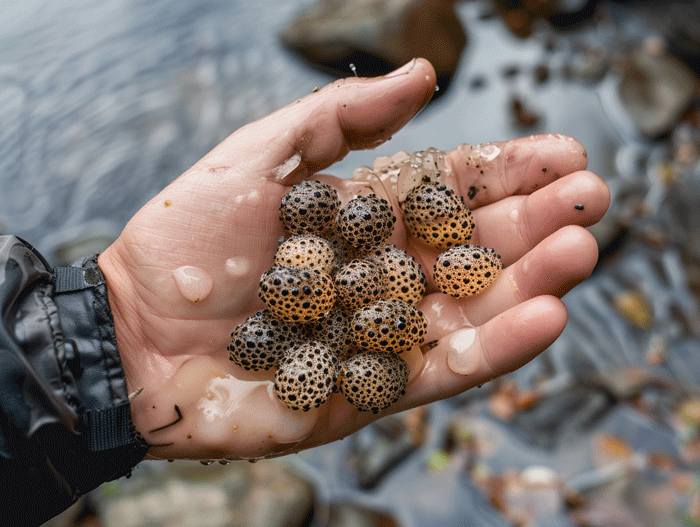Curious about what toad eggs look like? You’re in the right place! Toad eggs may not be something you come across every day, but they are fascinating to learn about. These small, jelly-like spheres can provide insight into the life cycle of these unique amphibians.
Toad eggs are often found in clusters and can vary in color and size depending on the species. Understanding the appearance of toad eggs can help you identify them in the wild and appreciate the wonder of nature. Let’s jump into the world of toad eggs and discover the beauty and complexity of these tiny treasures.
Key Takeaways
- Toad eggs come in various colors like black, brown, gray, and green, serving as a protective camouflage mechanism.
- The texture of toad eggs is gelatinous, forming compact clusters to safeguard them from environmental hazards.
- Toad eggs are fertilized externally in water, developing into embryos inside protective gelatinous capsules.
- Protective mechanisms for toad eggs include gelatinous coating, camouflage, chemical defense, parental care, and habitat selection.
Appearance of Toad Eggs
Toad eggs exhibit unique characteristics that make them easily distinguishable in nature. Understanding their appearance can enhance your appreciation for these fascinating creatures.

Color of Toad Eggs
- Toad eggs come in a range of colors, including black, brown, gray, and even shades of green depending on the species.
- The color of toad eggs serves as a protective mechanism, camouflaging them within their surroundings to evade predators.
- Spotting colored toad eggs amidst vegetation or water bodies can offer insight into the presence of these remarkable amphibians in the area.
- The texture of toad eggs is often described as gelatinous or jelly-like, forming compact clusters that adhere to surfaces.
- This sticky texture aids in keeping the eggs together and safeguarding them from environmental hazards.
- Observing the unique texture of toad eggs can provide valuable clues about the developmental stage of these amphibians in their life cycle.
Development of Toad Eggs

Fertilization Process
- Toad eggs are fertilized externally, where the female releases eggs and the male fertilizes them with sperm.
- The fertilization typically occurs in water, ensuring a suitable environment for the eggs’ development.
- After fertilization, toad eggs develop into embryos inside protective gelatinous capsules.
- As they mature, you can observe tiny tadpoles starting to form within the eggs.
- Eventually, fully developed tadpoles emerge from the eggs, ready to begin their journey to adulthood.
Protection of Toad Eggs

Toad eggs, even though their seemingly fragile appearance, are equipped with protective mechanisms that aid in their survival. Understanding the importance of safeguarding toad eggs is vital to the continuation of the toad population. Here’s a closer look at how toad eggs are protected:
- Gelatinous Coating: Toad eggs are encapsulated in a gelatinous substance that acts as a barrier against external threats. This coating provides physical protection for the developing embryos.
- Camouflage: The color and texture of toad eggs often mimic their surroundings, offering them a natural camouflage that helps them blend into their environment. This protective adaptation reduces the risk of detection by predators.
- Chemical Defense: Some species of toads produce toxic substances within their egg membranes, serving as a chemical defense mechanism against predators. This deterrent discourages consumption and enhances the survival chances of the eggs.
- Parental Care: In certain toad species, parents may exhibit parental care behaviors by guarding the eggs from potential threats. This investment in offspring increases the likelihood of egg survival.
- Habitat Selection: Toad parents often choose optimal locations for egg deposition, such as bodies of water with suitable environmental conditions. This strategic habitat selection enhances the protection of the eggs.
It is essential to recognize the various protective strategies that toad eggs employ to ensure their survival. By safeguarding these vulnerable stages of development, we contribute to the conservation of these fascinating amphibian species.
Conclusion
Toad eggs may seem delicate, but they are equipped with remarkable protective features. The gelatinous coating, natural camouflage, and sometimes toxic substances ensure the survival of developing embryos. Some toad species even exhibit parental care behaviors to enhance egg survival rates. Preserving these protective mechanisms is vital for the conservation of toad populations and the diverse amphibian species they represent. Understanding the intricacies of toad eggs not only enriches our knowledge but also underscores the importance of safeguarding these fascinating creatures for future generations.

Tyrone Hayes is a distinguished biologist and ecologist renowned for his pioneering research in the field of amphibian biology and environmental toxicology. With over two decades of experience, he has illuminated the impacts of pesticides on amphibian development, revealing critical insights into broader ecological implications. Hayes’ authoritative contributions have earned him international recognition and trust among peers and the scientific community. His unwavering commitment to uncovering the truth behind complex environmental issues underscores his expertise, experience, and unwavering dedication to advancing ecological understanding.
